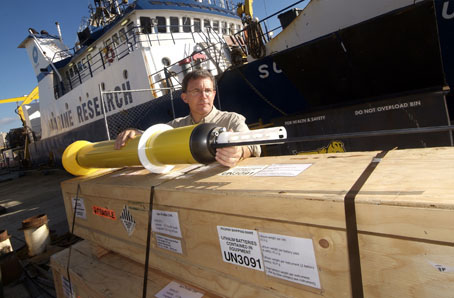The ocean’s capacity to absorb carbon dioxide and circulate vertically appears undiminished, according to a CSIRO study. [9 December 2008 | Peter Boyer]
Washing Tasmania’s southern shores is the world’s coldest, stormiest ocean, with a formidable and deserved reputation for making humans feel insignificant. As any round-the-world yachtie will tell you, the Southern Ocean is full of surprises.

Dr Steve Rintoul holds an Argo robotic profiler, which will be joining over 3000 others already at sea informing science about ocean temperature, salinity and circulation. PHOTO BRUCE MILLER
CSIRO oceanographer Dr Steve Rintoul, who has plied its waters many times over the years, will vouch for that. He’s a co-author of a study of Southern Ocean circulation which has revealed a surprising resilience in the ocean’s responses to rising carbon dioxide levels.
Thanks to burning of fossil fuels and rapid deforestation, there is more carbon dioxide in the atmosphere now than there’s been for hundreds of thousands, and very likely millions, of years. To reduce these high levels we’ll need all the help we can get.
Which is where our oceans come in. There are two big natural processes, or “sinks”, that remove carbon from the atmosphere: the growth of trees and other land plants, and the dissolving of carbon dioxide in the oceans.
Current scientific wisdom based on standard ocean models is that as ocean waters get warmer, their circulation – essential to the health of marine ecosystems – will tend to slow down and their capacity to absorb carbon dioxide will diminish.
But using observation data from a world-wide observing system of robotic ocean profilers called Argo floats, Dr Rintoul and his collaborators from Germany’s Institute of Marine Research found that the Southern Ocean is actually holding up well to changing conditions.
While the massive Antarctic Circumpolar Current has shifted slightly closer to Antarctica, it seems to have lost none of its capacity to absorb carbon dioxide from the air and to circulate its waters vertically, allowing nutrients to flow between surface and deep water.
The study found that while the power of stronger winds may be lessening, small-scale ocean eddies act to balance this. Today’s climate models can’t represent these small-scale motions, and overestimate the response of the Southern Ocean to changes in winds.
The many models used for the 2007 report of the Intergovernmental Panel on Climate Change were all global in their scope – designed to deal with broad-scale, long-term shifts in climate. At that resolution they seem to work well, because on a global scale there are broad boundaries and patterns that today’s computers can usefully interpret.
But modelling patterns at a higher resolution for more detailed information about a part of the planet – Tasmania, for instance, or segments of the Southern Ocean – has a higher level of uncertainty attached to it.
Dr Rintoul’s study addresses that uncertainty, emphasising the complexity and unpredictability of our world and reminding us of science’s continuing need for multiple methods and data sources.
Computer models are valuable tools for climate, as they are for other physical, economic and social phenomena. But as any tradesman knows, tools need to be used skilfully and within their limits – and they can never be a substitute for good workmanship, or good thinking.
